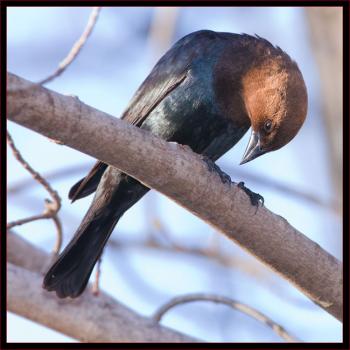A Burst of Bird Life
Anyone here in Maine spending tie outside and paying attention to birds over the last two weeks knows that things are topsy-turvy right now. We and many others have been seeing and reporting yards hopping with the activity of newly fledged young birds. Our yard has been filled with the almost constant chattering of a family of house wrens, a bird we devoted a column to earlier this summer. We hear young crows begging and making their off-key cawing around the neighborhood. At a friend’s place along Cobbosseecontee Stream in West Gardiner we listened to the constant squeaky calls of a newly fledged bald eagle urging its nearby parent to find more fish for it to gobble down. During a short boat ride upstream we saw a still tiny common loon chick being carefully monitored and protected by its handsome mom and dad.
Others have reported lots more baby bird sightings including several of brown-headed cowbird chicks being fed by their unknowingly duped parents. Brown-headed cowbirds are a highly unusual species in which the female lays her eggs in the nests of other species, never building her own nest. No brown-headed cowbird has ever been raised by a member of its own species. Typically, the species into which the cowbird sneakily drops her egg just keeps on incubating the cowbird egg along with their own. Some yellow warblers, a species often victimized by these nest parasites (as they are called), recognize that something is wrong and build a new nest over the old one. Yellow warblers that are repeatedly parasitized have been found with nests 5-7 layers deep as they keep trying to get a fresh start but are thwarted each time by another cowbird egg laid in the new nest.
Once the cowbird chick hatches in a parasitized nest, it typically is bigger than its nest mates and outcompetes them for food, sometimes resulting in the death of some or all of the actual offspring. Observers reported to the Maine birds listserve that they had seen northern cardinals and black-and-white warblers feeding newly fledged cowbirds this past week.
Along with all of the young birds around (which should be reported to the second year of the Maine Breeding Bird Atlas project, which we wrote about here last year), some birds are still trying to find mates or are trying for a second nesting. Some of these birds apparently make at least small-scale movements, putting them in new places for the birder who has been closely tallying birds at the same area through early summer. We had a loudly singing black-throated blue warbler show up at one of our favorite summer locales. The bird had clearly not been there earlier in the year, since its buzzy “I’m so laze” song can’t be easily missed. A black-and-white warbler has begun singing around dawn right outside our house; we’ve been hearing him from the bedroom window over the last week, presumably also a wandering male from somewhere not too far away.
It’s heartening to see and hear about so many fledgling birds bopping around, indicating a successful nesting season for some, hopefully many, species of birds. Enjoy the explosion of life while it is at its peak.
And remember to report any and all breeding activity to the Maine Breeding Bird Atlas!
Jeffrey V. Wells, Ph.D., is a Fellow of the Cornell Lab of Ornithology. Dr. Wells is one of the nation's leading bird experts and conservation biologists and author of “Birder’s Conservation Handbook”. His grandfather, the late John Chase, was a columnist for the Boothbay Register for many years. Allison Childs Wells, formerly of the Cornell Lab of Ornithology, is a senior director at the Natural Resources Council of Maine, a nonprofit membership organization working statewide to protect the nature of Maine. Both are widely published natural history writers and are the authors of the book, “Maine’s Favorite Birds” and “Birds of Aruba, Bonaire, and Curaçao: A Site and Field Guide” from Cornell Press.





























